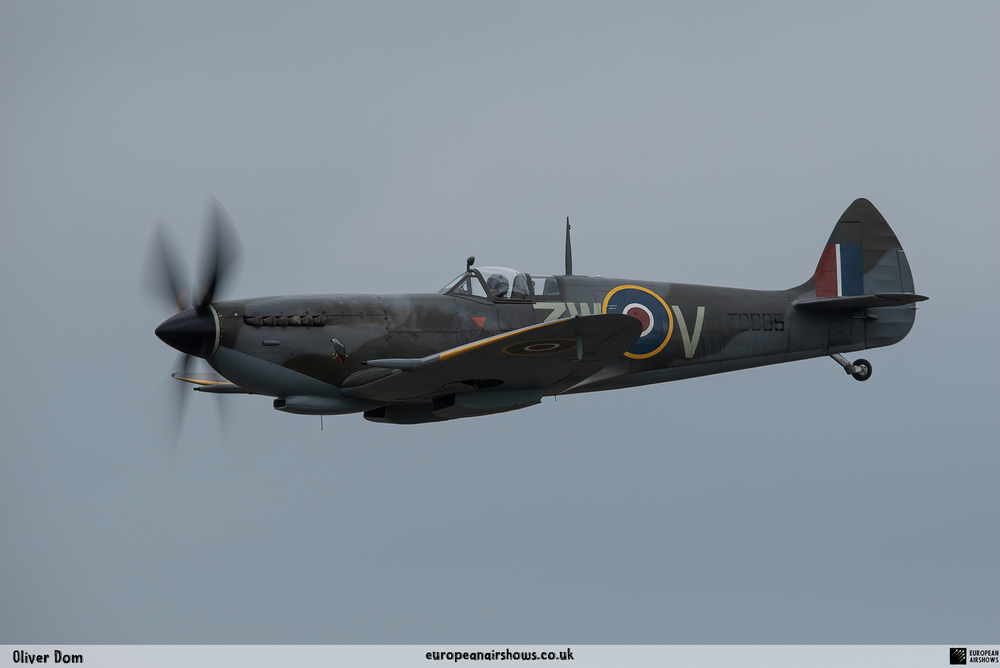Spitfire PH-FVE
Year built
1945
Aircraft
Spitfire LF.XVI
Base
Gilze-Rijen Air Base
The Spitfire Mk XVI ‘TB885’ left the production plant in 1945 and was taken on strength with the Royal Air Force later that year where it served in the No. 322 (Dutch) Squadron.
TB885 was also used by RAF Kenley for fire fighting practise and was in the background of the movie Reach for the Sky, September 1955.
In 1959 the TB885 was buried in the fire dump and in April 1982 was recovered by Shoreham Aircraft Preservation Society.
In 1985 the Spitfire was passed to Lashenden Air Warfare Museum, Sevenoaks, before being transferred to Shoreham Aircraft Museum in 1991 for long-term restoration.
On the 5th of December 2017, the aircraft was sold to Godefridus Franciscus Theodorus Van Eerd from the Netherlands.
On the 4th of August 2018 after a ground-up restoration by the Biggin Hill Heritage Hangar TB885 performed its first post-restoration flight with civil registration G-CKUE.
On the 31st of May 2019, the Spitfire was ferried to Eindhoven Air Base before being officially delivered to the Netherlands later that year.
On the 7th of June 2019, the TB885 arrived at Leeuwarden Air Base escorted by two Royal Netherlands Air Force F-16s and a single Hawker Hunter from the Dutch Hawker Hunter Foundation.
On the 10th of August 2020, the aircraft was sold to Stichting Flying Vintage Everyday and a week later on the 17th of August 2020 received a new civil registration PH-FVE and flew to Gilze-Rijen Air Base where it remains to this day in the main hangar of the Koninklijke Luchtmacht Historische Vlucht (Royal Air Force Historic Flight).
| Back to Top |
Supermarine Spitfire LF.XVI
The Supermarine Spitfire is a British single-seat fighter aircraft that was used by the Royal Air Force and other Allied countries before, during, and after World War II. Many variants of the Spitfire were built, using several wing configurations, and it was produced in greater numbers than any other British aircraft. It was also the only British fighter produced continuously throughout the war. The Spitfire continues to be popular among enthusiasts; nearly 60 remain airworthy, and many more are static exhibits in aviation museums throughout the world.
The Spitfire was designed as a short-range, high-performance interceptor aircraft by R. J. Mitchell, chief designer at Supermarine Aviation Works, which operated as a subsidiary of Vickers-Armstrong from 1928. Mitchell pushed the Spitfire's distinctive elliptical wing with cutting-edge sunken rivets (designed by Beverley Shenstone) to have the thinnest possible cross-section, helping give the aircraft a higher top speed than several contemporary fighters, including the Hawker Hurricane. Mitchell continued to refine the design until his death in 1937, whereupon his colleague Joseph Smith took over as chief designer, overseeing the Spitfire's development throughout its multitude of variants.
During the Battle of Britain, from July to October 1940, the public perceived the Spitfire to be the main RAF fighter, though the more numerous Hurricane shouldered a greater proportion of the burden against Nazi Germany's air force, the Luftwaffe. However, Spitfire units had a lower attrition rate and a higher victory-to-loss ratio than those flying Hurricanes because of Spitfire's higher performance. During the battle, Spitfires were generally tasked with engaging Luftwaffe fighters—mainly Messerschmitt Bf 109E-series aircraft, which were a close match for them.
After the Battle of Britain, the Spitfire superseded the Hurricane to become the backbone of RAF Fighter Command and saw action in the European, Mediterranean, Pacific, and South-East Asian theatres. Much loved by its pilots, the Spitfire served in several roles, including interceptor, photo-reconnaissance, fighter-bomber, and trainer, and it continued to serve in these roles until the 1950s. The Seafire was a carrier-based adaptation of the Spitfire that served in the Fleet Air Arm from 1942 through to the mid-1950s. Although the original airframe was designed to be powered by a Rolls-Royce Merlin engine producing 1,030 hp (768 kW), it was strong enough and adaptable enough to use increasingly powerful Merlins and, in later marks, Rolls-Royce Griffon engines producing up to 2,340 hp (1,745 kW). As a result, the Spitfire's performance and capabilities improved over the course of its service life.
The Mk LFIXe Spitfire was built in March 1944 and fitted with a Merlin 66 engine with a two-speed, two-stage supercharger optimised for low altitudes.
| Back to Top |

| Back to Top |






